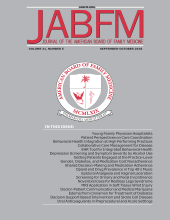Brief ReportBrief Report
How Do Family Physicians Provide Anticipatory Guidance during Well-Child Visits?
Rodney Young and John Boltri
The Journal of the American Board of Family
Practice September 2005, 18 (5) 440-444; DOI: https://doi.org/10.3122/jabfm.18.5.440

References
- ↵U.S. Department of Health and Human Services, Public Health Service, Centers for Disease Control and Prevention, National Center for Health Statistics, 2001. Available from: www.aafp.org/x24578.xml.
- ↵Guirguis-Blake J, Fryer GE, Deutchman M, Green LA, Dovey SM, Phillips RL. Graham Center one-pager no. 15: Family physicians increase provision of well-infant care despite decline in prenatal services. November 2002. Available from: www.aafppolicy.org/x390.xml.
- ↵Galuska DA, Fulton JE, Powell KE, et al. Pediatrician counseling about preventive health topics: results from the Physicians’ Practices Survey, 1998–1999. Pediatrics 2002; 109: E83–3.
- ↵Cheng TL, DeWitt TG, Savageau JA, O’Connor KG. Determinants of counseling in primary care pediatric practice: physician attitudes about time, money and health issues. Arch Pediatr Adolesc Med 1999; 153: 629–35.
- ↵Wright MS. Pediatric injury prevention. Preparing residents for patient counseling. Arch Pediatr Adolesc Med 1997; 151: 1039–43.
- ↵Stickler GB, Simmons PS. Pediatricians’ preferences for anticipatory guidance topics compared with parental anxieties. Clin Pediatr 1995; 34: 384–7.
- ↵Schuster MA, Duan N, Regalado M, Klein DJ. Anticipatory guidance: what information do parents receive? What information do they want? Arch Pediatr Adolesc Med 2000; 154: 1191–8.
- ↵Bethell C, Peck C, Schor E. Assessing health system provision of well-child care: the promoting healthy development survey. Pediatrics 2001; 107: 1084–94.
- ↵Glascoe FP, Oberklaid MD, Dworkin PH, Trimm F. Brief approaches to educating patients in primary care. Pediatrics 1998;101:e10. Available from: http://www.pediatrics.org/cgi/content/full/101/6/e10.
- ↵Minkovitz CS, Hughart N, Strobino D, et al. A practice-based intervention to enhance quality of care in the first 3 years of life: The healthy steps for young children program. JAMA 2003; 290: 3081–91.
- ↵Busey S, Schum TR, Meurer JR. Parental perceptions of well-child care visits in an inner-city clinic. Arch Pediatr Adolesc Med 2002; 156: 62–6.
- ↵American Academy of Family Physicians membership survey data. Available from: http://www.aafp.org/x951.xml.
- ↵American Academy of Family Physicians membership survey data. Available from: http://www.aafp.org/x763.xml.
- ↵
- Chande VT, Wyss N, Exum V. Education interventions to alter pediatric emergency department utilization patterns. Arch Pediatr Adolesc Med 1996; 150: 525–8.
- Gablehouse BL, Gitterman BA. Maternal understanding of commonly used medical terms in a pediatric setting [abstract]. Am J Dis Child 1990; 144: 419.
- ↵Spiers PS, Guntheroth WG. Recommendations to avoid the prone sleeping position and recent statistics for sudden infant death syndrome in the United States. Arch Pediatr Adolesc Med 1994; 148: 141–6.
- ↵Madlon-Kay DJ. Use of a structured encounter form to improve well-child care documentation. Arch Fam Med 1998; 7: 480–3.
- ↵Kaszuba Duggan A, Starfield B, DeAngelis C. Structured encounter form: the impact on provider performance and recording of well-child care. Pediatrics 1990; 85: 104–13.
- ↵Krejcie RV, Morgan DM. Determining sample size for research activities. Educ Psychol Meas 1970; 30: 607–10.
In this issue
The Journal of the American Board of Family
Practice
Vol. 18, Issue 5
1 Sep 2005
How Do Family Physicians Provide Anticipatory Guidance during Well-Child Visits?
Rodney Young, John Boltri
The Journal of the American Board of Family
Practice Sep 2005, 18 (5) 440-444; DOI: 10.3122/jabfm.18.5.440
Jump to section
Related Articles
- No related articles found.
Cited By...
- No citing articles found.






